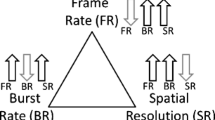Abstract
In a typical optical test, a stereo camera pair is required to measure the three-dimensional motion of a test article; one camera typically only measures motions in the image plane of the camera, and measurements in the out-of-plane direction are missing. Finite element expansion techniques provide a path to estimate responses from a test at unmeasured degrees of freedom. Treating the case of a single camera as a measurement with unmeasured degrees of freedom, a finite element model is used to expand to the missing third dimension of the image data, allowing a full-field, three-dimensional measurement to be obtained from a set of images from a single camera. The key to this technique relies on the mapping of finite element deformations to image deformations, creating a set of mode shape images that are used to filter the response in the image into modal responses. These modal responses are then applied to the finite element model to estimate physical responses at all finite element model degrees of freedom. The mapping from finite element model to image is achieved using synthetic images produced by a rendering software. The technique is applied first to a synthetic deformation image, and then is validated using an experimental set of images.


















Similar content being viewed by others
References
O’Callahan JC, Avitable P, Riemer R (1989) System equivalent reduction expansion process
Witt BL, Rohe DP, Schoenherr TF (2019) Full field strain shape estimations from 3D SLDV. In: Niezrecki C, Baqersad J, Di Maio D (eds) Rotating machinery, optical methods & scanning LDV methods of conference proceedings of the society for experimental mechanics, vol 6. Springer, Cham, pp 31–45
Soine DE, Jones RJ, Harvie JM Jr, Skousen TJ, Schoenherr TF (2019) Designing Hardware for the Boundary Condition Round Robin Challenge. In: Mains M, Dilworth B (eds) Topics in Modal Analysis & Testing, volume 9. Conference Proceedings of the Society for Experimental Mechanics Series. Springer, Cham, https://doi.org/10.1007/978-3-319-74700-2_12, (to appear in print)
Rohe DP (2020) An optical test simulator based on the open-source Blender software. In: Proceedings of the 38th international modal analysis conference, (Houston TX)
The Blender Foundation (2019) Blender.org. https://www.blender.org/. Accessed 2019-02-24
Bradski G (2000) The openCV library,. Dr.Dobb’s J Softw Tools 25:120–125
Lepetit V, Moreno-Noguer F, Fua P (2008) EPNp: An accurate O(n) solution to the PnP problem. Int J Comput Vis 81:155
Turner DZ (2015) Digital image correlation engine (DICe) reference manual, Sandia Report SAND2015-10606 O Sandia National Laboratories
Allemang RJ, Brown DL (1982) A correlation coefficient for modal vector analysis. In: Proceedings of the 1st international modal analysis conference, vol 1, pp 110–116, SEM Orlando
Avitabile P, Pingle P (2012) Prediction of full field dynamic strain from limited sets of measured data. Shock Vib 19:765–785
Allemang RJ (2003) The modal assurance criterion–twenty years of use and abuse. Sound Vib 37(8):14–23
Thibault L, Butland A, Avitabile P (2012) Variability improvement of key inaccurate node groups – VIKING. In: Allemang R, De Clerck C, Niezrecki C, Blough J (eds) Topics in Modal Analysis II, vol 6. Springer, New York, pp 603–624
Fowler D, Schultz R, Zwink B, Owens B (2019) Flight environments demonstrator: part III – sensitivity of expansion to model accuracy. In: Proceedings of the 37th international modal analysis conference society for experimental mechanics
Jones E, Reu P (2018) Distortion of digital image correlation (DIC) displacements and strains from heat waves. Exp Mech 58:1133–1156
Author information
Authors and Affiliations
Corresponding author
Ethics declarations
Conflict of interests
The authors declare that they have no conflict of interest.
Additional information
Publisher’s Note
Springer Nature remains neutral with regard to jurisdictional claims in published maps and institutional affiliations.
Sandia National Laboratories is a multimission laboratory managed and operated by National Technology, Engineering Solutions of Sandia, LLC, a wholly owned subsidiary of Honeywell International Inc., for the U.S. Department of Energy’s National Nuclear Security Administration under contract DE-NA0003525. This paper describes objective technical results and analysis. Any subjective views or opinions that might be expressed in the paper do not necessarily represent the views of the U.S. Department of Energy or the United States Government.
Rights and permissions
About this article
Cite this article
Rohe, D., Witt, B. & Schoenherr, T. Predicting 3D Motions from Single-Camera Optical Test Data. Exp Tech 45, 313–327 (2021). https://doi.org/10.1007/s40799-020-00391-8
Received:
Accepted:
Published:
Issue Date:
DOI: https://doi.org/10.1007/s40799-020-00391-8




